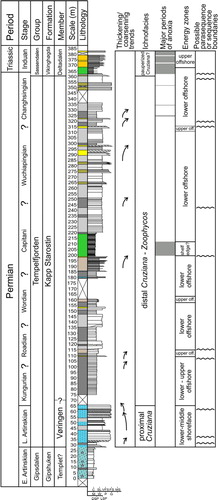Figures & data
Fig. 1 Map of Svalbard with exposures of Carboniferous–Permian rocks in green. Structural elements: A: Sørkapp–Hornsund High; B: Central Trough (St. Johnsfjorden Trough); C: Nordfjorden High; D: Billefjorden Trough; E–F: Ny Friesland Trough. Major fault lineaments are also shown. Modified from Nakrem et al. (Citation1992).
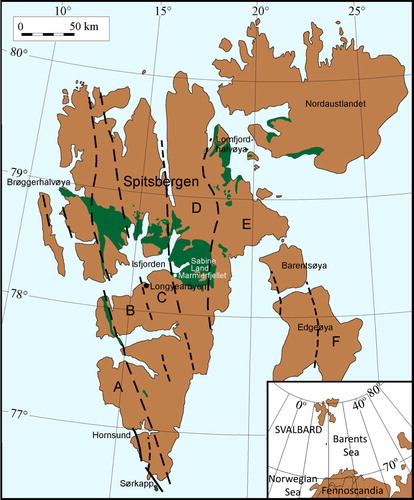
Fig. 2 (a) Picture taken from Sassenfjorden looking south towards the outcrops. White lines indicate the location of the measured profiles. (b) Geological map showing the profile lines. Modified from Major et al. (Citation1992).
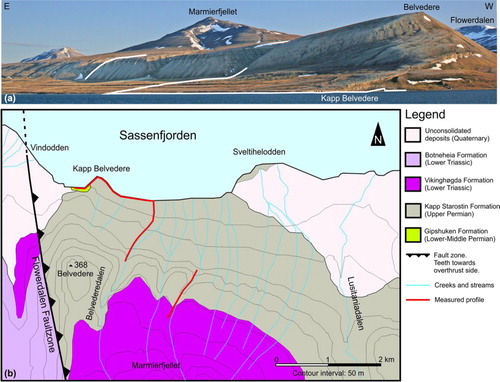
Fig. 3 Fence diagram showing thickness and lateral development of the main lithological units within the Kapp Starostin Formation. The abrupt change from sandy spiculitic facies to black organic shale has been used as a datum because this lithological change is easily seen in the field and is very close to the Permian–Triassic boundary. Modified from Worsley et al. (Citation1986), Fredriksen (Citation1988) and Henriksen (Citation1988).
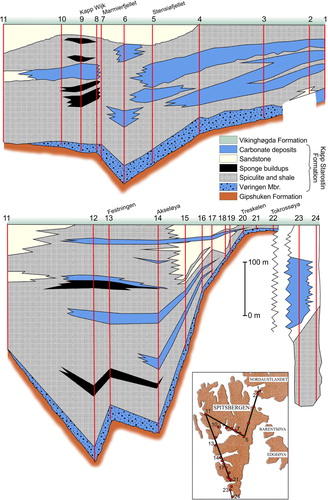
Fig. 4 Sedimentological log showing the vertical range of trace fossils, Marmierfjellet, central Spitsbergen. See text for discussion of the stratigraphy. The grain size of siliciclastic material and classification of the limestone deposits according to Dunham (Citation1962) is shown along the X axis. Dark and light spiculites are abbreviated as DSP and LSP, respectively.
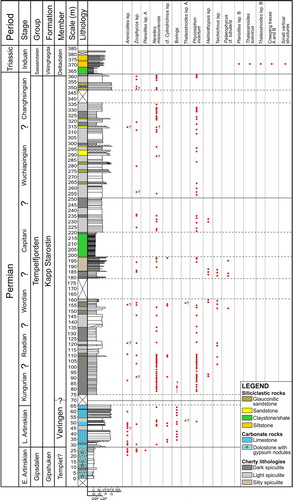
Fig. 5 Trace fossils of the Kapp Starostin Formation. (a), (b) Arenicolites isp. in vertical cross-section of sandstone beds from the lower part of the section (0–26 m). (c) Chondrites isp. (Ch) on the upper surface of a sandstone bed, ca. 120 m of the section. (d) Cf. Cylindrichnus isp. (Cy) on the upper surface of a sandstone bed, 120 m of the section. (e) Cf. Cylindrichnus isp. (Cy) and Zoophycos isp. (Zo) on the horizontal section of a bed, 120 m of the section, INGUJ207P2a. (f)–(h) Macaronichnus segregatis (Ma) in loose blocks. Cross-section in (h); (f) INGUJ207P18, (h) INGUJ207P13a.
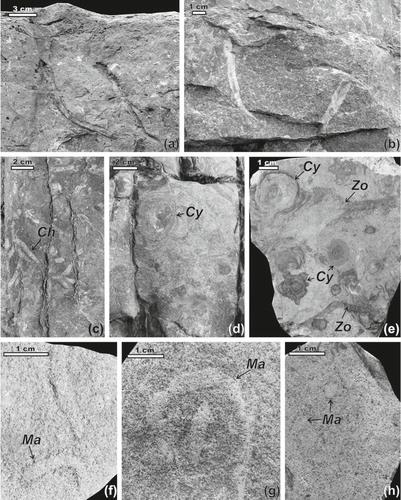
Fig. 12 Other borings in brachiopod shells. (a) Cf. Conchotrema isp. A. (b) Pinaceocladichnus isp. (c) Cf. Conchotrema isp. B. (d) ?Talpina isp. B. (e) Cf. Conchotrema isp. B. (f) Palaeosabella prisca. (g) cf. Conchotrema isp. B. (h) Contorted tubes and cf. Conchotrema isp. B. (CB).
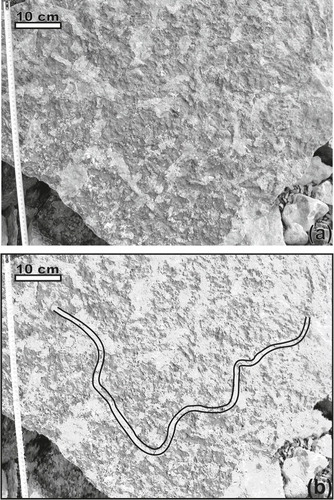
Fig. 13 Borings in brachiopod shells. (a) Rogerella isp. in pedicle valve of spiriferid brachiopod. (b) Rogerella isp. and small galleries (sg). (c) Cf. Oichnus (Oi) and small galleries (sg) marked by small tunnels and holes. (d) ?Talpina isp. A on the inner side of the valve. (e) cf. Conchotrema isp. A. (f) ?Talpina isp. A.
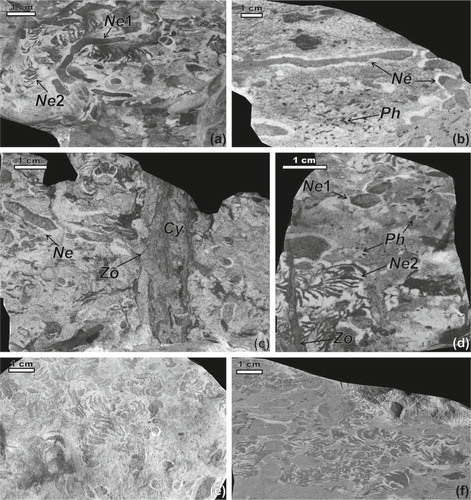
Fig. 6 Helminthopsis isp. on the lower surface of a sandstone bed from the lower part of the section. (a) View of the slab. (b) Drawing showing Helminthopsis isp.
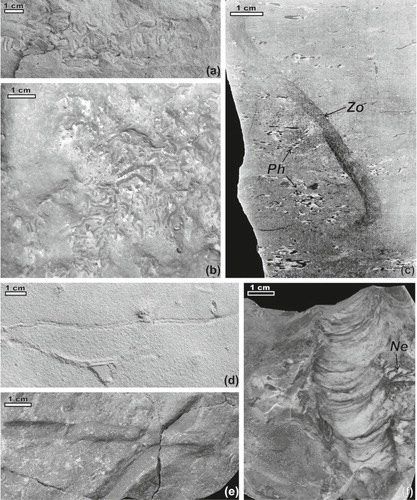
Fig. 7 Nereites missouriensis and other trace fossils from the Kapp Starostin Formation on (a)–(d), (f) polished slabs or (e) rough surfaces. (a) N. missouriensis seen as continuous ribbons (Ne1) or chains of scaliform menisci (Ne2), 56 m of the section, INGUJ207P6. (b) N. missouriensis (Ne) and Phycosiphon incertum (Ph), 318 m of the section, INGUJ207P3a. (c) N. missouriensis (Ne), Zoophycos isp. (Zo) and cf. Cylindrichnus isp. (Cy), 74.5 m of the section, INGUJ207P7. (d) N. missouriensis seen as continuous ribbons (Ne1) or chains of scaliform menisci (Ne2), Zoophycos isp. (Zo) and Phycosiphon incertum (Ph), 95 m of the section, INGUJ207P28. (e), (f) N. missouriensis, (e) 153 m of the section, (f) 305–306 m of the section, INGUJ207P10.
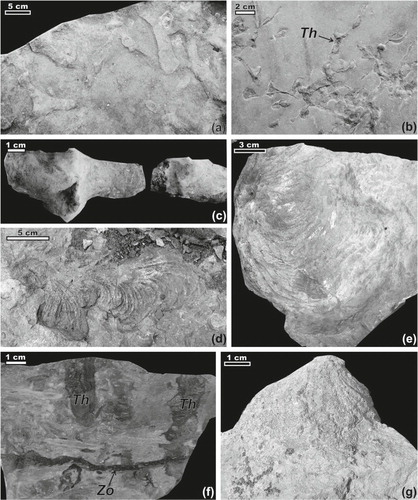
Fig. 8 Some spreite and simple trace fossils from (a)–(c), (d) the Triassic deposits, (e) the Gipsuken Formation and (f) the Kapp Starostin Formation. (a)–(b) Phycosiphon incertum on a rough bedding surface (a) 152–155 m of the section, (b) from a loose slab. (c) Phycosiphon incertum (Ph) and Zoophycos isp. (Zo) in vertical cross-section, 150 m of the section. (d) Palaeophycus cf. tubularis, bedding surface. (e) Planolites isp. A, bedding surface, lower part of the section (0–26 m). (f) Teichichnus isp. crossing N. missouriensis (Ne), 77 m of the section, INGUJ207P9.
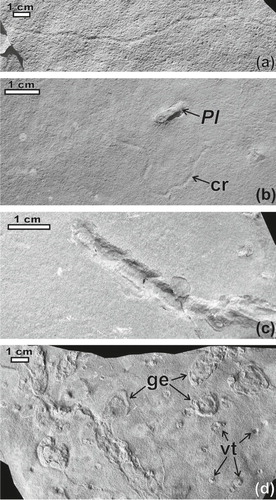
Fig. 9 Other trace fossils from (a) and (b) the Triassic deposits and (c)–(g) the Kapp Starostin Formation. (a) Thalassinoides suevicus, bedding surface. (b) Thalassinoides isp. A (Th), bedding surface. (c) ?Thalassinoides isp. B, fragments of filling, 121 m of the section, INGUJ207P22 (left) and INGUJ207P23 (right). (d)–(e) Zoophycos isp. on bedding surface, lower part of the section (10–26 m). (f) Zoophycos isp. (Zo) and ?Thalassinoides isp. B (Th), vertical section, 155.5 m of the section, INGUJ207P4a. (g) Steeply inclined spreite of Zoophycos isp., 273–276 m of the section.
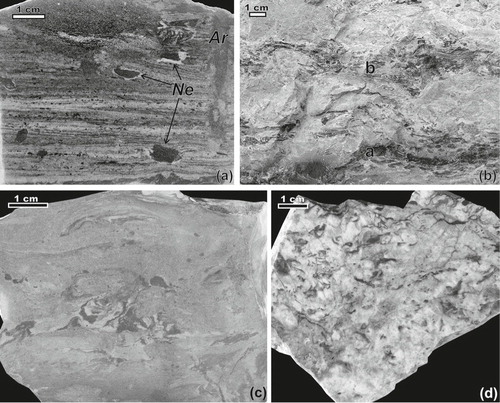
Fig. 10 Trace fossils from the Triassic on bedding surfaces. (a) Creeping trace A. (b) Creeping trace A (cr) and Planolites isp. (Pl). (c) Creeping trace B, INGUJ207P36. (d) Small vertical structures (vt) and probable gas escape structures (ge), 395.5 m of the section, INGUJ207P35.
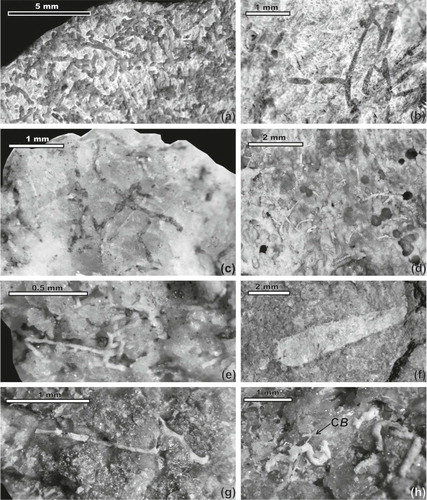
Table 1 Trace fossils from the studied deposits.
Fig. 14 Sedimentological log for the Marmierfjellet section. Interpretation of anoxicity is expressed as V/(V+Ni) ratio of shales differentiating between oxic, dysoxic, anoxic and sulphidic bottom-water conditions during deposition.
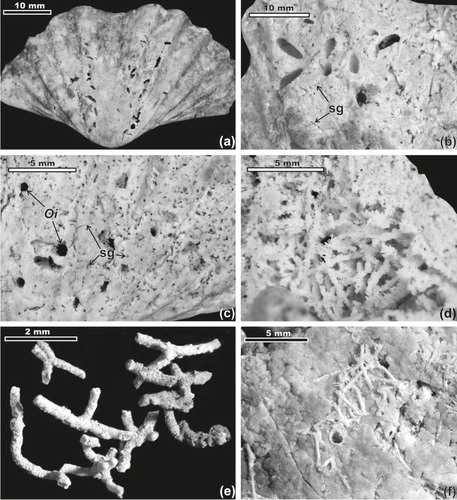
Fig. 15 A close-up of the element ratio V/(V+Ni) ratio of shales for the Permian–Triassic transition at the Marmierfjellet. At the Permian–Triassic transition, the bottom water fluctuated between anoxic and sulphidic conditions followed by more stable anoxic conditions.
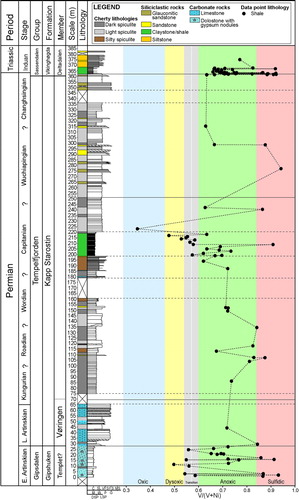
Fig. 16 Main sedimentological and ichnofacies interpretation of subenvironments, oxygenation and sequence/parasequence boundaries. See legend in Fig. 4.
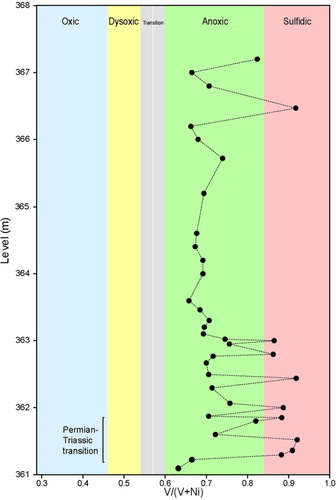
Fig. 11 Some ichnological features of the Kapp Starostin Formation. (a) Nereites missouriensis (Ne) and ?Arenicolites isp. (Ar) crossing primary cross lamination, 55 m of the section. (b) Two horizons (a, b) with abundant Nereites missouriensis, 200–220 m of the section. (c) Smeared Nereites missouriensis due to deformation in a very soft sediment, 349.8 m of the section, INGUJ207P12. (d) Obliterated Nereites missouriensis due to silicification, 102 m of the section, INGUJ207P25.
